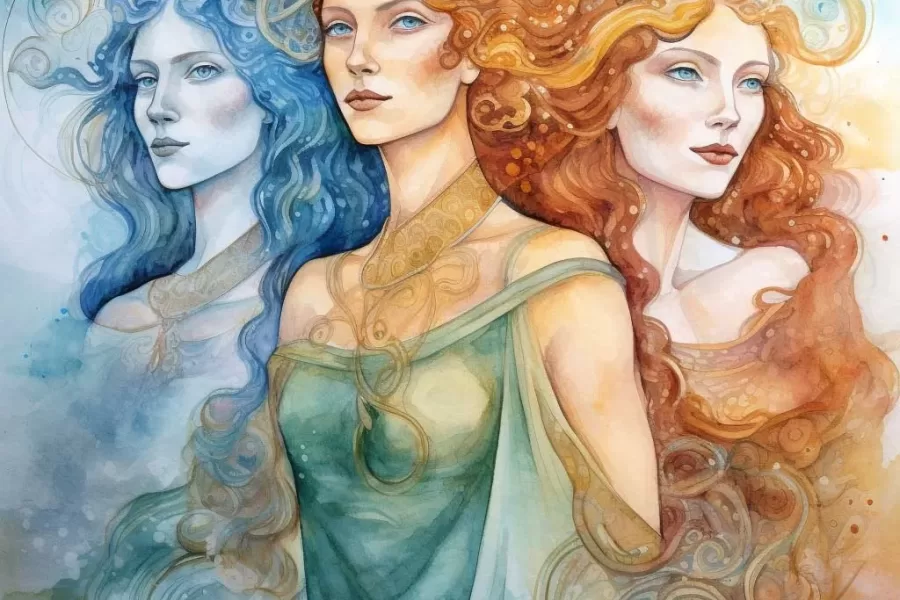Celtic mythology is rich with gods and goddesses that are believed to have shaped the universe and the lives of the people. The Celtic pantheon includes a vast array of deities, including some powerful goddesses. In this definitive guide, we will explore some of the most significant Celtic goddesses and their roles in mythology and the culture of the Celts.
Overview of Celtic Mythology
Celtic mythology is a collection of stories and beliefs that were held by the ancient Celts, who lived in parts of Europe from around 1200 BCE to the 5th century CE. Their mythology was influenced by their religion, which centered around nature and the worship of natural forces. The Celts believed that their gods and goddesses had the power to control the natural world, including the weather, the seasons, and the growth of crops.
The mythology of the Celts was passed down through oral tradition, and as a result, many of the stories have been lost. However, some of the myths have survived and have been recorded in writing by scholars over the centuries. Celtic mythology has had a significant impact on modern culture, with many of its themes and characters still appearing in literature, film, and other forms of art.
The Importance of Goddesses in Celtic Mythology
In Celtic mythology, goddesses held significant roles and were considered to be powerful beings who controlled various aspects of life. They were often associated with fertility, childbirth, and the cycles of nature. Many of the goddesses were also warriors and protectors, representing strength and courage.
Unlike in other ancient mythologies, where male gods were dominant, the Celtic pantheon was fairly balanced between male and female deities. This is evidence of the Celts’ respect for women, who played important roles in their society as healers, leaders, and mothers. The goddesses were often portrayed as having a close relationship with the land, and many were associated with specific places or natural features such as rivers, mountains, or forests.
Brigid, the Goddess of Poetry, Healing, and Smithing
Brigid, also known as Brigit or Brighid, was one of the most important goddesses in Celtic mythology. She was a triple goddess, representing the three aspects of fire: poetry, healing, and smithcraft. Brigid was associated with the arrival of spring and the return of light after the dark winter months.
As the goddess of poetry, Brigid was revered by bards and storytellers, who believed that she inspired them to create works of great beauty and power. She was also known as a healer, with her sacred wells said to have healing properties. In addition, Brigid was associated with the craft of metalworking and was believed to be the patron goddess of blacksmiths.
The Morrigan, the Goddess of War and Fate
The Morrigan was a powerful goddess who was associated with war and fate. She was a triple goddess, often depicted as a trio of sisters or as a shape-shifter who could take on various forms, including that of a crow. The Morrigan was said to appear on the battlefield before important battles, predicting the outcome and sometimes choosing who would live or die.
The Morrigan was also associated with sovereignty, the power to rule and protect a kingdom. She was said to test the courage and worthiness of kings, and to grant or withhold her favor based on their actions. The Morrigan was a complex figure, sometimes seen as a terrifying force of destruction, and at other times as a protector of the weak and oppressed.
Epona, the Goddess of Horses
Epona was a goddess who was associated with horses and horsemanship. She was believed to protect horses and riders, and was often depicted as a woman riding a horse or standing beside one. Epona was also associated with fertility and abundance, and her worship was particularly popular among the Gaulish and Roman cavalry.
Epona was believed to have the power to protect travelers and ensure safe journeys, and many people would offer her gifts before setting out on long journeys. She was also seen as a protector of the natural world and was associated with the cycles of life and death.
Danu, the Mother Goddess
Danu was the mother goddess of the Tuatha Dé Danann, the ancient Irish gods and goddesses. She was believed to be the mother of all the gods and was associated with fertility, motherhood, and the cycles of nature. Danu was a nurturing figure who protected her children and provided for their needs.
Danu was associated with the land and the natural world, and her worship was closely tied to agriculture and the growth of crops. She was also a goddess of the otherworld, the realm of the gods and spirits that was believed to exist alongside the mortal world.
Rhiannon, the Goddess of Love and the Otherworld
Rhiannon was a Welsh goddess who was associated with love, beauty, and the otherworld. She was often depicted riding a white horse and was considered to be a protector of travelers and a guide to the otherworld. Rhiannon was also associated with fertility and abundance, and her worship was closely tied to the cycles of nature.
Rhiannon’s story is one of devotion and sacrifice. According to legend, she married a mortal man who was accused of stealing her horse. To clear his name, Rhiannon chose to take the blame and was punished by being forced to carry travelers on her back for years. Eventually, she was able to clear her name and was reunited with her husband.
List of Celtic Goddesses
Here is an extensive list of Celtic goddesses, their names, and what they were worshipped for:
- Aine – goddess of love, fertility, and sovereignty
- Andraste – goddess of victory, invoked in times of war
- Badb – goddess of war, death, and prophecy
- Brigid – goddess of poetry, healing, and smithing
- Cerridwen – goddess of wisdom, transformation, and inspiration
- Danu – mother goddess of the Tuatha Dé Danann
- Epona – goddess of horses and horsemanship
- Flidais – goddess of the hunt, wild animals, and fertility
- Macha – goddess of sovereignty, war, and fertility
- Morrigan – goddess of war, fate, and sovereignty
- Nantosuelta – goddess of nature, prosperity, and fertility
- Rhiannon – goddess of love, beauty, and the otherworld
- Sirona – goddess of healing, fertility, and the sun
- Sulis – goddess of healing, the sun, and hot springs
- Tailtiu – goddess of agriculture, harvest, and fertility
- Thea – goddess of light, the sun, and the moon
- Tlachtga – goddess of fertility, birth, and death
- Airmid – goddess of healing and medicine
- Anu – goddess of fertility, prosperity, and protection
- Banba – goddess of the land, agriculture, and fertility
Celtic Pantheon
Celtic mythology is rich with stories of gods and goddesses who shaped the world and the lives of the people who worshipped them. The goddesses of the Celtic pantheon were powerful figures who represented the forces of nature, fertility, and protection. They were often associated with specific places or natural features and were revered for their strength, beauty, and wisdom.
While the stories of the Celtic goddesses have been passed down through oral tradition and recorded in writing, their influence can still be felt in modern culture. Their stories continue to inspire and captivate people today, reminding us of the power and beauty of the natural world and the importance of balance and respect in our relationships with others.







